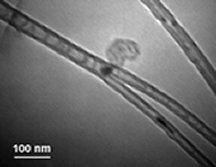Y-shaped nanotubes might become a common component in ultrasmall electronic circuitry, according to scientists who have just shown that the microscopic, branched structures can function as transistors.

The microelectronics industry has been on the lookout for a radically new type of transistor because manufacturers are approaching physical limits on the number of transistors that they can pack into a chip. In a typical transistor, an electrical signal applied to one part of the component determines the flow of electricity through the rest. As the amount of chip space per transistor dwindles, engineers are finding it difficult to create small-enough conventional silicon transistors that are effective.
Y junctions made of nanotubes could come to the rescue, say Prabhakar R. Bandaru of the University of California, San Diego (UCSD) and his colleagues there and at Clemson (S.C.) University. The junctions are a variant of conventional carbon nanotubes—minuscule pipes of extraordinary strength and electrical conductivity that are composed of one or more concentric layers of carbon atoms (SN: 8/20/05, p. 115: Fine Fabric: New, fast way to make sheets of nanotubes).
Other researchers had shown that a straight carbon nanotube could act as a field-effect transistor (FET), the predominant type of transistor in today’s microchips (SN: 5/9/98, p. 294). In the September Nature Materials, Bandaru and his coworkers report that a Y junction can do the same in a much smaller space than its nonbranching cousin can.
The shrinkage was possible because there’s no need for a broad metal electrode, called the gate, which lies underneath the nanotube in a straight-nanotube FET. The gate’s voltage controls the nanotube’s current. Instead, any leg of a nanotube Y junction can control current passing through the junction’s other two segments, Bandaru says.
The new work “is a truly significant step in nanoelectronics,” says Hongqi Xu of Lund University in Sweden in a commentary in the same issue of Nature Materials. It “implies that realization of an entirely new class of functional circuits that extends well beyond today’s FET architecture is now possible,” Xu adds.
Unbranched carbon nanotubes typically grow from a carbon-rich vapor in a furnace containing metal seed particles that catalyze nanotube formation. Clemson’s Apparao M. Rao forced tubes to branch into Y-shaped structures by depositing onto tube walls additional iron-titanium seeds that instigated offshoots to sprout.
In subsequent experiments on those branched tubes, Bandaru and his UCSD colleagues demonstrated that varying the amount of voltage applied to one leg of the Y could switch on or off current flowing between the other two legs. Although some theorists had previously proposed that Y junctions might act as FETs, researchers don’t yet know what characteristics of the nanotubes—perhaps their shape or the iron-titanium particles—are responsible for their transistor function.
Despite the Y junctions’ promise, the new components have some serious drawbacks. For one, a segment that’s been switched off still permits large amounts of electrical current, up to 30 percent of the total flow, to leak through, Bandaru notes. What’s more, the devices operate only at thousands of cycles per second rather than the billions that are now routine for microchips.
To emerge as successors to silicon, the branched nanotubes may have to compete with technologies such as semiconductor nanowires (SN: 5/22/04, p. 325: Branching Out: Semiconducting nanotrees could boost electronics) and circuit components based on individual organic molecules, such as rotaxanes (SN: 2/7/04, p. 87: Virtual Nanotech).
While acknowledging these shortcomings and challenges, Bandaru points out that the junctions tested so far provide merely a “proof of principle.” The early signs are promising enough that he and others expect soon to develop carbon-nanotube Y junctions with improved performance.





